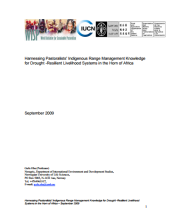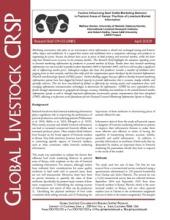/ library resources
Showing items 1 through 9 of 68.The study discusses land-degradation in pastoral communities and depicts land-use system and associated human and livestock population pressure as the major determinant of vegetation cover, surface run-off, soil erosion, and species richness.
The year of 2008 marked the beginning of a new phase at ICARDA: the full implementation of the Center's Strategic Plan 2007-2016, and a renewed commitment to addressing the global challenges of food security, poverty alleviation and climate change in the dry areas.
ICARDA’s West Asia Regional Program (WARP) coordinates agricultural research and development activities in Cyprus, Iraq, Jordan, Lebanon, the Palestinian Authority, Syria and lowland Turkey.
The livelihood of the Himalayan people depends on rangeland-based livestock farming in Nepal. Above 2500 m altitude, the contribution of rangelands to livestock feed supply is more than 65%.
This report on harnessing pastoralists’ indigenous knowledge of rangeland management in three countries in East and the Horn of Africa is presented in two parts. The first part presents a review of the literature.
The environment is the basic determinant of the nature and productivity of rangeland eco-systems. Physical environmental factors, which include climate, topography and soil, determine the potential of rangeland to support certain types and levels of land use.
The interaction between ecological and hydrological processes is particularly important in arid and semi-arid regions. Often the interaction between these processes is not completely understood and they are studied separately.
Marketing transactions take place in an environment where information is shared and exchanged among and between sellers, buyers and middlemen.
Paginering
Land Library Search
Through our robust search engine, you can search for any item of the over 73,000 highly curated resources in the Land Library.
If you would like to find an overview of what is possible, feel free to peruse the Search Guide.








